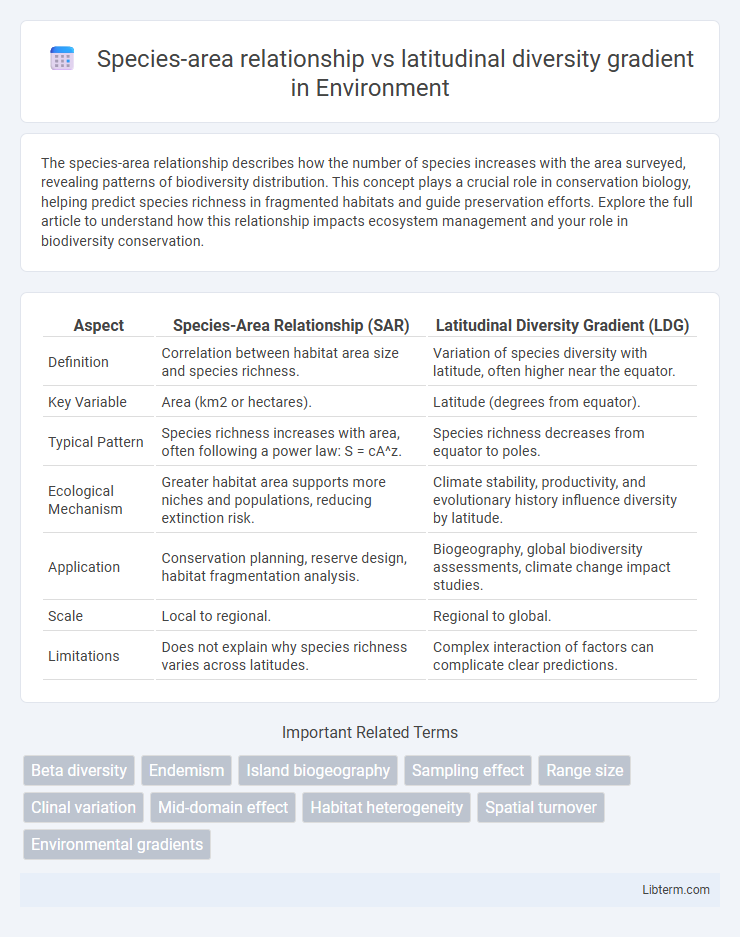The species-area relationship describes how the number of species increases with the area surveyed, revealing patterns of biodiversity distribution. This concept plays a crucial role in conservation biology, helping predict species richness in fragmented habitats and guide preservation efforts. Explore the full article to understand how this relationship impacts ecosystem management and your role in biodiversity conservation.
Table of Comparison
| Aspect | Species-Area Relationship (SAR) | Latitudinal Diversity Gradient (LDG) |
|---|---|---|
| Definition | Correlation between habitat area size and species richness. | Variation of species diversity with latitude, often higher near the equator. |
| Key Variable | Area (km2 or hectares). | Latitude (degrees from equator). |
| Typical Pattern | Species richness increases with area, often following a power law: S = cA^z. | Species richness decreases from equator to poles. |
| Ecological Mechanism | Greater habitat area supports more niches and populations, reducing extinction risk. | Climate stability, productivity, and evolutionary history influence diversity by latitude. |
| Application | Conservation planning, reserve design, habitat fragmentation analysis. | Biogeography, global biodiversity assessments, climate change impact studies. |
| Scale | Local to regional. | Regional to global. |
| Limitations | Does not explain why species richness varies across latitudes. | Complex interaction of factors can complicate clear predictions. |
Understanding the Species-Area Relationship
The species-area relationship quantifies how species richness increases with habitat area, reflecting habitat heterogeneity and resource availability. This relationship underpins biodiversity patterns observed in the latitudinal diversity gradient, where tropical regions exhibit higher species richness partly due to larger contiguous habitats. Understanding species-area dynamics enables prediction of species loss from habitat fragmentation and informs conservation strategies in biodiversity hotspots along latitudinal gradients.
Defining the Latitudinal Diversity Gradient
The latitudinal diversity gradient (LDG) describes the increase in species richness from the poles toward the equator, making tropical regions the most biodiverse on Earth. This gradient contrasts with the species-area relationship, which emphasizes that larger geographic areas support more species due to increased habitat heterogeneity and resource availability. Understanding the LDG involves exploring climatic stability, productivity, and evolutionary history that collectively influence global patterns of biodiversity.
Historical Context and Discovery of Both Patterns
The species-area relationship was first documented in the early 20th century through island biogeography studies by ecologists such as MacArthur and Wilson, revealing that larger areas support more species due to habitat diversity and reduced extinction rates. The latitudinal diversity gradient, observed since the 19th century by naturalists like Alexander von Humboldt, highlights a systematic increase in species richness from the poles to the tropics, shaped by factors such as climate stability and evolutionary history. Both patterns have become fundamental in ecology and biogeography, providing insights into biodiversity distribution and the effects of spatial and climatic variables on species richness.
Mechanistic Explanations for Species-Area Relationship
Mechanistic explanations for the species-area relationship emphasize habitat heterogeneity, resource availability, and population dynamics as key drivers influencing species richness on larger land areas. Edge effects and habitat fragmentation also modulate species distribution patterns, reinforcing the positive correlation between area size and biodiversity. These processes differ from the latitudinal diversity gradient, which primarily attributes species richness variation to climatic factors and evolutionary history across latitudes.
Drivers of Latitudinal Diversity Gradient
The latitudinal diversity gradient, characterized by increasing species richness from poles to the tropics, is driven primarily by factors such as temperature, productivity, and evolutionary history. Unlike the species-area relationship, which focuses on habitat size and its impact on species count, latitudinal diversity gradients emphasize climate stability, higher solar energy input, and longer time for speciation in tropical regions. These drivers promote greater niche specialization and higher population sizes, facilitating biodiversity accumulation along latitudinal gradients.
Comparative Analysis: Area vs. Latitude in Biodiversity
The species-area relationship quantifies how biodiversity increases with habitat size, emphasizing that larger areas support more species due to greater habitat heterogeneity and resource availability. In contrast, the latitudinal diversity gradient highlights the decline in species richness from equatorial regions to polar areas, driven by climatic stability and productivity differences. Comparative analysis reveals that while area primarily dictates local species richness, latitude governs broader biogeographic patterns, with interactive effects influencing global biodiversity distribution.
Case Studies Illustrating Both Patterns
Case studies in the Amazon rainforest demonstrate the species-area relationship as larger forest fragments support exponentially more species, reflecting habitat diversity and resource availability. Research across Pacific islands highlights the latitudinal diversity gradient, showing species richness decreases from the equator towards higher latitudes due to climatic factors and evolutionary history. Comparative analyses of coral reef ecosystems reveal how both patterns operate simultaneously, with species richness influenced by island size and proximity to the equator, offering insights into biodiversity conservation strategies.
Ecological and Evolutionary Implications
Species-area relationship reveals how habitat size directly influences biodiversity, highlighting the importance of conserving large, contiguous ecosystems to maintain species richness. Latitudinal diversity gradient demonstrates the increase in species diversity toward the equator due to factors such as higher primary productivity and evolutionary rates, offering insights into mechanisms driving speciation and extinction. Both patterns underscore ecological and evolutionary processes, including niche specialization and adaptive radiation, shaping global biodiversity distribution.
Exceptions and Contrasting Examples
Species-area relationship generally predicts increasing species richness with larger habitat areas, yet some island ecosystems like Krakatoa show delayed or limited species accumulation post-eruption, contrasting typical expectations. Latitudinal diversity gradient typically shows higher biodiversity near the equator but unique cases like the Mediterranean Sea exhibit high marine species richness despite temperate latitudes. These exceptions highlight the influence of historical events, environmental stability, and evolutionary processes that modify classical biodiversity patterns.
Integrating Species-Area and Latitudinal Gradients in Conservation Strategies
Integrating species-area relationships and latitudinal diversity gradients enhances conservation strategies by addressing spatial scale and biodiversity richness simultaneously. Conservation planning that combines habitat area considerations with latitudinal patterns optimizes the protection of species richness and endemism hotspots. Applying this integrated approach improves resource allocation for preserving biodiversity across tropical, temperate, and polar regions.
Species-area relationship Infographic

 libterm.com
libterm.com